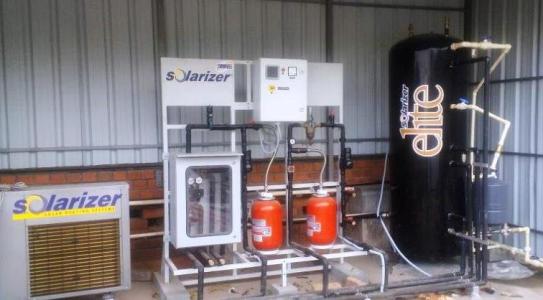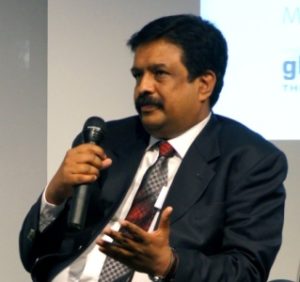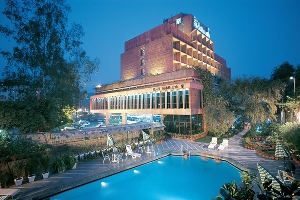India: Hybrid Solar Heat Pump System Brings Power Consumption down by a Factor 10 on sunny days
March 16, 2016
 The solar hot water system based on thermosiphon technology works only during sunny days. During monsoon and overcast days, however, it is necessary to use alternative means of heating, largely based on electricity. In addition, when more hot water is required temporarily, the solar thermal storage tank restricts the capacity available for the next day – unless auxiliary electrical heating is used. To improve hot water availability, Indian solar water heater manufacturer Emmvee Solar has developed a hybrid system called Solarizer Elite, a combination of a pumped solar system and a heat pump, which is suitable for large homes with hot water demand for multiple applications. Emmvee has installed around ten systems during a field test.
The solar hot water system based on thermosiphon technology works only during sunny days. During monsoon and overcast days, however, it is necessary to use alternative means of heating, largely based on electricity. In addition, when more hot water is required temporarily, the solar thermal storage tank restricts the capacity available for the next day – unless auxiliary electrical heating is used. To improve hot water availability, Indian solar water heater manufacturer Emmvee Solar has developed a hybrid system called Solarizer Elite, a combination of a pumped solar system and a heat pump, which is suitable for large homes with hot water demand for multiple applications. Emmvee has installed around ten systems during a field test.Photo: Emmvee Solar
The tank water is heated either by the solar collector or the air-to-water heat pump. An electric controller decides automatically which power source (solar or heat pump) will be used. Optionally, the system comes with a device to measure electricity consumption. The installation is designed for both newbuilds and building retrofits. It is available in sizes ranging from a capacity of 500 litres to 3,000 litres per day. The heat pumps have an electric power output of between 1.3 and 9 kW.
The Solarizer Elite hot water system has two heat exchanger coils inside the tank, both fully coated with enamel. One of the coils is connected to the collector, the other to the heat pump. The coils use glycol as the heat transfer fluid. The solar circuit system has its own pumps and controls to ensure that a maximum of solar energy is utilized for heating water, and the auxiliary heating source turns on automatically to ensure hot water in the storage tank at all times.
Hybrid system needs only about a tenth of electric geyser power on a sunny day
Emmvee’s electricity and cost-saving calculation was made for a typical 500-litre hybrid system, which can deliver up to 750 litres per day. The basis for calculation was the provision of 750 litres of hot water by an electric geyser – without solar or heat pump. Usually, the installation requires 4 kWh per 100 litres of hot water, which means that the benchmark electricity demand was 30 kWh per day.
First step was to calculate the savings of a 500-liter solar system during a normal sunny day which reaches 20 kWh of electricity (4 kWh times 5).
The additional requirement of 250 litres of hot water per day would consume 10 kWh of electricity when provided by an electric element alone. Using an air-to-water heat pump reduces electricity demand to a mere 3.5 kWh.
So against the benchmark of 30 kWh
Therefore, calculating the savings – 20 kWh from solar and 6.5 kWh from the heat pump – the hybrid system brings daily power consumption down by a factor 10, to 3.5 kWh per day.
At an electricity price of 7 INR/kWh (0.1 EUR/kWh), this means INR 185.5 (EUR 2.65) saved each day. Assuming 300 operational days per year, the figure even adds up to almost INR 55,650 (EUR 750) – an attractive option for homeowners.
More information:


